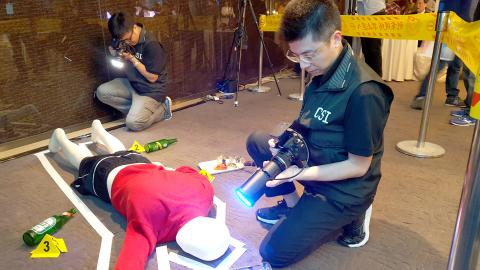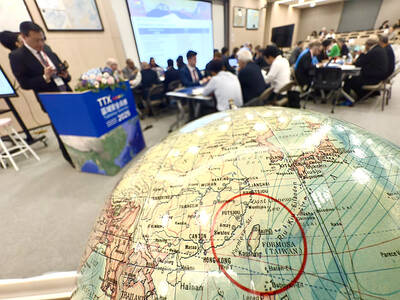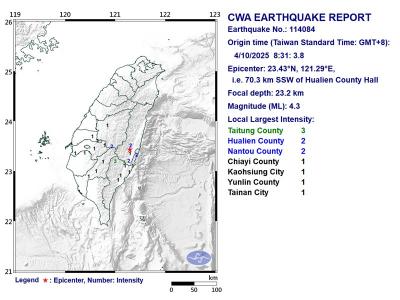Forensic scientist Henry Lee (李昌鈺) and National Applied Research Laboratories (NARL) on Tuesday unveiled a forensic camera that can detect injuries and evidence beneath the skin that are invisible to the naked eye.
One of the most difficult aspects of collecting evidence at crime scenes is detecting invisible injuries, as it takes time for a bruise to develop, and the window between the onset of a violent incident and the detection of noticeable injuries is a period when forensic medical examination is inadequate.
NARL developed imaging technology able to detect ruptured blood vessels and blood extravasation beneath the skin by measuring blood oxygen levels with a blue and ultraviolet dual-light device, NARL researcher Mark Lin (林宇軒) said.

Photo: Chen Wei-han, Taipei Times
“Blood contains hemoglobin and bilirubin, which turn fluorescent when exposed to blue and ultraviolet lights. The light emitted by hemoglobin and bilirubin exhibits different colors depending on blood-oxygen levels,” Lin said.
“Lower blood oxygenation occurs when blood vessels are ruptured and blood congeals, so forensic scientists can determine the scope and severity of injuries beneath the skin with images taken by the device,” Lin said.
“Traditionally, investigators rely on experience and the colors of a bruise — if there is one — to determine when an injury was inflicted, but now they can estimate the time of injury with more precision by measuring blood oxygen levels,” Lee said.
The device can be used to help victims of domestic violence and sexual assaults in which injuries might be less apparent, Lee said.
The forensic camera can also take pictures of fingerprints and body fluids, and the data can then be instantly transmitted to a crime laboratory anywhere in the world, enabling data-matching to be undertaken and senior investigators to direct crime-scene investigations remotely.
Lee demonstrated a remote crime-scene investigation with the forensic camera, as he instructed two rookie investigators on what evidence to collect and where to collect it via a computer screen, with images of the scene and fingerprints displayed in real time.
That could help understaffed police units to process a crime scene in a professional manner, he said.
“Such technology can take the crime lab to the crime scene, instead of the other way around, as we are used to. The technology can also be used to fight terrorism on a global level, as images taken at a certain location can be immediately analyzed by experts around the world,” Lee said.

Taiwan is stepping up plans to create self-sufficient supply chains for combat drones and increase foreign orders from the US to counter China’s numerical superiority, a defense official said on Saturday. Commenting on condition of anonymity, the official said the nation’s armed forces are in agreement with US Admiral Samuel Paparo’s assessment that Taiwan’s military must be prepared to turn the nation’s waters into a “hellscape” for the Chinese People’s Liberation Army (PLA). Paparo, the commander of the US Indo-Pacific Command, reiterated the concept during a Congressional hearing in Washington on Wednesday. He first coined the term in a security conference last

DEFENSE: The National Security Bureau promised to expand communication and intelligence cooperation with global partners and enhance its strategic analytical skills China has not only increased military exercises and “gray zone” tactics against Taiwan this year, but also continues to recruit military personnel for espionage, the National Security Bureau (NSB) said yesterday in a report to the Legislative Yuan. The bureau submitted the report ahead of NSB Director-General Tsai Ming-yen’s (蔡明彥) appearance before the Foreign and National Defense Committee today. Last year, the Chinese People’s Liberation Army (PLA) conducted “Joint Sword-2024A and B” military exercises targeting Taiwan and carried out 40 combat readiness patrols, the bureau said. In addition, Chinese military aircraft entered Taiwan’s airspace 3,070 times last year, up about

A magnitude 4.3 earthquake struck eastern Taiwan's Hualien County at 8:31am today, according to the Central Weather Administration (CWA). The epicenter of the temblor was located in Hualien County, about 70.3 kilometers south southwest of Hualien County Hall, at a depth of 23.2km, according to the administration. There were no immediate reports of damage resulting from the quake. The earthquake's intensity, which gauges the actual effect of a temblor, was highest in Taitung County, where it measured 3 on Taiwan's 7-tier intensity scale. The quake also measured an intensity of 2 in Hualien and Nantou counties, the CWA said.

The Overseas Community Affairs Council (OCAC) yesterday announced a fundraising campaign to support survivors of the magnitude 7.7 earthquake that struck Myanmar on March 28, with two prayer events scheduled in Taipei and Taichung later this week. “While initial rescue operations have concluded [in Myanmar], many survivors are now facing increasingly difficult living conditions,” OCAC Minister Hsu Chia-ching (徐佳青) told a news conference in Taipei. The fundraising campaign, which runs through May 31, is focused on supporting the reconstruction of damaged overseas compatriot schools, assisting students from Myanmar in Taiwan, and providing essential items, such as drinking water, food and medical supplies,